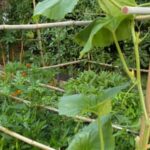Wood ecology mulch is a sustainable and environmentally-friendly practice gaining popularity among vegetable gardeners. This article explores the numerous benefits of incorporating wood ecology mulch into your vegetable garden. From improving soil health to increasing productivity, wood ecology mulch offers gardeners a natural solution to enhance their gardening efforts and support sustainable practices.
Vegetable gardens can greatly benefit from the use of wood ecology mulch. One of the key advantages is its ability to retain moisture in the soil, reducing water evaporation and ensuring plants have access to a consistent water supply. This not only saves time and effort on watering but also helps create an optimal growing environment for vegetables.
In addition to moisture retention, wood ecology mulch acts as a barrier between the soil surface and the air, preventing erosion caused by heavy rain or wind. This protects delicate vegetable roots from being exposed or damaged, enabling them to grow strong and healthy. Furthermore, wood ecology mulch suppresses weed growth by creating a physical barrier that blocks sunlight and hinders weed seed germination.
By embracing the use of wood ecology mulch in your vegetable garden, you can experience improved soil health, reduced maintenance needs, and increased productivity. The subsequent sections of this article will delve deeper into understanding what wood ecology mulch is, how it enhances soil health, factors to consider when choosing the right type of mulch for your garden, proper techniques for application, common mistakes to avoid, long-term benefits, and success stories from other vegetable gardens utilizing this sustainable practice.
With this knowledge at hand, you can optimize your vegetable garden’s potential and contribute towards a healthier environment.
What is Wood Ecology Mulch
Wood ecology mulch is a type of mulch that is made from woody materials, such as tree bark, wood chips, or sawdust. It is commonly used in vegetable gardens as a means to improve soil health and provide various benefits to the plants. Understanding the composition and characteristics of wood ecology mulch can help gardeners make informed decisions about its use in their own gardens.
The composition of wood ecology mulch can vary depending on the source material used. It typically consists of shredded or chipped pieces of wood, which can range in size from small pieces to larger chunks. The type of wood used can also differ, with options including hardwoods like oak or softwoods like pine. Additionally, some manufacturers may add organic matter or other additives to enhance the mulch’s performance.
One of the key characteristics of wood ecology mulch is its ability to retain moisture in the soil. The layer of mulch acts as a barrier between the soil and the air, reducing evaporation and helping to keep the soil moist for longer periods. This is particularly beneficial for vegetable gardens, as it ensures that plants have access to a consistent water supply, even during hot and dry periods.
In addition to retaining moisture, wood ecology mulch also helps prevent soil erosion. The layer of mulch covers the surface of the soil, protecting it from heavy rain or irrigation that could wash away valuable topsoil. By preventing erosion, wood ecology mulch helps maintain healthy soil structure and reduces nutrient loss.
Furthermore, one significant advantage of using wood ecology mulch is its ability to suppress weeds. The layer of mulch creates a physical barrier that blocks sunlight from reaching weed seeds or existing weeds, preventing them from germinating or growing. This not only reduces competition for nutrients but also minimizes the need for manual weeding or herbicides in vegetable gardens.
Overall, understanding the composition and characteristics of wood ecology mulch allows gardeners to harness its benefits effectively. By retaining moisture, preventing erosion, and suppressing weeds, this type of mulch improves soil health and promotes optimum conditions for vegetable growth.
How Wood Ecology Mulch Enhances Soil Health
Wood ecology mulch plays a crucial role in enhancing soil health in vegetable gardens. Its unique characteristics and composition provide several benefits that contribute to the overall health and productivity of the soil. This section will explore how wood ecology mulch retains moisture, prevents erosion, and suppresses weeds, highlighting its importance in maintaining optimal growing conditions for vegetable plants.
Retaining Moisture
One of the key advantages of using wood ecology mulch in vegetable gardens is its ability to retain moisture. By covering the soil surface with a layer of mulch, evaporation is minimized, reducing water loss from the soil. The mulch acts as a barrier between the sun’s rays and the soil, preventing rapid drying and helping to conserve moisture.
In addition to conserving water, wood ecology mulch also promotes better moisture distribution within the soil. It acts as an insulator, regulating temperature fluctuations that can lead to uneven water distribution. This helps ensure that each plant receives adequate hydration for proper growth and development.
Preventing Erosion
Another important benefit of wood ecology mulch is its ability to prevent erosion in vegetable gardens. During heavy rain or watering, bare soil can easily erode and wash away valuable nutrients essential for plant growth. However, when a layer of wood ecology mulch is applied to the soil surface, it acts as a protective barrier against erosive forces.
The mulch helps break up raindrops upon impact with the ground, preventing them from dislodging soil particles and causing erosion. Additionally, it creates a network of interlocking fibers that stabilize the topsoil structure and reduce runoff. This not only preserves precious nutrients but also ensures that the roots of vegetable plants remain firmly anchored in place.
Suppressing Weeds
Weed control is another significant advantage provided by wood ecology mulch in vegetable gardens. When properly applied at an adequate depth, the mulch forms a physical barrier that prevents weed seeds from germinating and growing. This minimizes competition for nutrients, water, and sunlight, giving vegetable plants a better chance to thrive.
Moreover, the dark color of wood ecology mulch absorbs heat from the sun, creating an unfavorable environment for weed growth. By raising the temperature at the soil surface, the mulch inhibits weed seed germination. Additionally, as weeds do manage to sprout through the mulch layer, they are typically weak and easily pulled out due to their struggle to penetrate the dense fibrous barrier.
Choosing the Right Type of Wood Ecology Mulch for Your Vegetable Garden
Wood ecology mulch comes in various types and forms, each with its own unique set of characteristics and benefits. When choosing the right type of wood ecology mulch for your vegetable garden, it is important to consider several factors that will contribute to the overall success of your garden. These factors include the type of wood, particle size, and availability.
1. Type of Wood: The type of wood used for mulch can have an impact on the soil health and nutrient composition. Some common types of wood used for mulch include cedar, cypress, pine, and hardwood.
Cedar mulch is known for its natural insect-repellent properties and ability to resist decomposition, making it a popular choice among gardeners. Cypress mulch is highly resistant to rotting and offers excellent moisture retention properties. Pine and hardwood mulches are readily available and offer good weed suppression qualities.
2. Particle Size: The particle size of the wood ecology mulch will determine how well it prevents weed growth, retains moisture, and allows for air circulation in the soil. Finely shredded or chipped mulch tends to interlock tightly, reducing weed growth and promoting moisture retention. Larger-sized chips may not provide as effective weed suppression but can help with erosion control.
3. Availability: Consider the availability of different types of wood ecology mulch in your area. Some types may be more readily available than others, depending on your location. Additionally, you may want to consider sourcing local or sustainably harvested wood ecology mulch to minimize environmental impact.
Once you have considered these factors, you can make an informed decision about which type of wood ecology mulch will best suit your vegetable garden’s needs. Remember that even within these general guidelines, there might be variations based on personal preferences or specific requirements of certain vegetables or plants in your garden.
Step-by-Step Guide to Applying Wood Ecology Mulch in Vegetable Gardens
Wood Ecology Mulch can be a valuable addition to your vegetable garden, improving soil health and increasing productivity. However, it is important to apply the mulch correctly in order to reap its full benefits. This step-by-step guide will walk you through the process of applying wood ecology mulch in your vegetable garden, ensuring proper techniques and best practices.
1. Prepare the Soil: Before applying wood ecology mulch, it is important to prepare the soil properly. This includes removing any existing weeds or debris from the garden bed and loosening the soil with a garden fork or tiller. Make sure the soil is well-drained and has adequate fertility for optimal plant growth.
2. Choose the Right Mulching Material: Selecting the right type of wood ecology mulch is crucial for its effectiveness in your vegetable garden. Consider factors such as moisture retention, weed suppression, and decomposition rate when choosing your mulching material. Common options include wood chips, shredded bark, or straw.
3. Apply an Even Layer of Mulch: Once you have chosen your mulching material, it’s time to apply it to your vegetable garden. Start by spreading a layer of mulch that is approximately 2-3 inches thick evenly across the entire garden bed. Avoid piling up mulch around the base of plants, as this can lead to moisture retention issues and pest problems.
4. Leave Space Around Plant Stems: When applying wood ecology mulch, make sure to leave a small space around the stems of vegetables or other plants. This will prevent excess moisture from collecting around the base of plants and causing rot or disease.
5. Replenish Mulch as Needed: Over time, wood ecology mulch will break down and decompose, so it is important to replenish it regularly. Add a fresh layer of mulch every 6-12 months, depending on how quickly it breaks down in your specific climate and growing conditions.
By following these step-by-step instructions for applying wood ecology mulch in your vegetable garden, you can ensure that you are using proper techniques and best practices for optimal results. Remember to choose the right type of mulching material, apply an even layer, leave space around plant stems, and replenish the mulch as needed. With these practices in place, you can enjoy the benefits of improved soil health and increased productivity in your vegetable garden.
Preparing the Soil for Wood Ecology Mulch
Wood Ecology Mulch is a valuable tool for enhancing soil health and productivity in vegetable gardens. However, in order to maximize the benefits of using this mulch, it is essential to properly prepare the soil before applying it. Preparing the soil creates optimal conditions for growth and allows the wood mulch to have the greatest impact on the garden.
One important step in preparing the soil for wood ecology mulch is removing any existing weeds or vegetation. Weeds can compete with your vegetables for nutrients and water, reducing their overall health and productivity. It is best to remove weeds by hand or with a cultivator rather than using herbicides, as chemical residues can negatively impact both the effectiveness of the wood ecology mulch and the health of your plants.
Another key aspect of soil preparation is ensuring proper drainage. Excessive water retention can lead to root rot and other diseases in vegetables. Before applying wood ecology mulch, make sure that your garden has adequate drainage by checking that water does not pool on the surface or linger in low-lying areas. If necessary, you may need to amend the soil with organic matter or install drainage systems.
To provide an optimal environment for your vegetable plants, it is also important to test and adjust the pH levels of the soil. Most vegetables prefer slightly acidic soil with a pH range between 6.0 and 6.5.
You can test your soil’s pH using a home testing kit or by sending a sample to a laboratory for analysis. If your pH levels are outside of the desired range, you may need to add lime (to raise pH) or sulfur (to lower pH) to bring them into balance.
By carefully preparing your soil before applying wood ecology mulch, you are setting up your vegetable garden for success. This step ensures that your plants have access to nutrients, proper drainage, and balanced pH levels – all factors critical for healthy growth and high yields.
Relevant and useful data:
| Soil Preparation Steps | Benefits |
|---|---|
| Remove weeds and vegetation | Prevents competition for nutrients and water |
| Create proper drainage | Prevents root rot and other diseases |
| Test and adjust pH levels of the soil | Provides an optimal environment for vegetable growth |
Common Mistakes to Avoid When Using Wood Ecology Mulch in Vegetable Gardens
When using wood ecology mulch in vegetable gardens, it’s important to be aware of common mistakes to avoid in order to ensure successful outcomes. By troubleshooting and implementing the following tips, gardeners can maximize the benefits of wood ecology mulch while avoiding potential pitfalls.
One common mistake to avoid is applying too much mulch. While mulch is beneficial for retaining moisture and suppressing weeds, excessive amounts can create an environment that is too moist and may lead to root rot or fungal diseases. To prevent this, it’s recommended to apply a layer of mulch that is no more than 2-3 inches deep. This thickness allows for proper water absorption while still providing weed suppression.
Another mistake to watch out for is not properly preparing the soil before applying wood ecology mulch. It’s important to remove any existing weeds or grass from the area and loosen the soil with a garden fork or tiller before laying down the mulch. This helps prevent weeds from growing through the mulch and ensures better contact between the mulch and soil, facilitating nutrient transfer.
Additionally, gardeners should avoid placing wood ecology mulch directly against plant stems or tree trunks. This can create a moist environment that promotes rot or disease in the plants. Instead, leave a small gap around each plant stem or trunk to allow for air circulation and reduce the risk of moisture-related issues.
By being mindful of these common mistakes when using wood ecology mulch in vegetable gardens, gardeners can troubleshoot potential problems and optimize their gardening practices. Following these tips will help maintain healthy soil conditions, prevent issues such as root rot or weed overgrowth, and promote overall success in vegetable garden growth.
| Common Mistakes | Troubleshooting Tips |
|---|---|
| Applying too much mulch | Apply a layer no more than 2-3 inches deep |
| Not preparing the soil properly | Remove existing weeds or grass and loosen the soil before laying down mulch |
| Placing mulch directly against plant stems or trunks | Leave a small gap to allow for air circulation and reduce moisture-related issues |
Long-Term Benefits of Wood Ecology Mulch in Vegetable Gardens
Using wood ecology mulch in vegetable gardens offers a range of long-term benefits that can help sustain soil health and increase productivity. One of the key advantages is improved soil structure. As the mulch breaks down over time, it adds organic matter to the soil, which improves its structure by increasing its ability to hold water and nutrients. This leads to enhanced root development and overall plant growth.
In addition to improving soil structure, wood ecology mulch also helps regulate soil temperature. The layer of mulch acts as an insulator, protecting the soil from extreme temperature fluctuations. This is especially important during hot summer months when the soil can dry out quickly. By maintaining a more consistent temperature, the mulch ensures optimal growing conditions for vegetables, resulting in healthier plants and higher yields.
Another long-term benefit of using wood ecology mulch in vegetable gardens is its ability to promote beneficial microbial activity. The decomposition process of the mulch releases organic compounds into the soil, providing a food source for microorganisms such as bacteria and fungi.
These microorganisms play a crucial role in breaking down organic matter and releasing nutrients that are essential for plant growth. By supporting a thriving microbial community, wood ecology mulch enhances nutrient cycling in the soil and promotes the overall health of the garden ecosystem.
Overall, incorporating wood ecology mulch into your vegetable garden can have significant long-term benefits for both the health of your soil and the productivity of your crops. It improves soil structure, regulates temperature, and promotes beneficial microbial activity.
By sustaining soil health over time, you can create a more resilient garden that produces abundant harvests year after year. In the next section, we will explore some success stories of vegetable gardens that have utilized wood ecology mulch to achieve these long-term benefits.
Case Studies
Wood ecology mulch has gained popularity among vegetable gardeners for its numerous benefits in enhancing soil health and increasing productivity. Many gardeners have reported success stories after incorporating wood ecology mulch into their vegetable gardens. These case studies serve as inspiration for others looking to maximize yield and embrace sustainable practices in their own gardens.
Case Study 1: Increased Soil Moisture Retention and Improved Plant Growth
One success story comes from Sally, a vegetable gardener from Maine. Sally decided to try using wood ecology mulch in her garden after experiencing problems with soil moisture retention and growth of her plants. She applied a layer of wood chips around her tomato plants and was amazed at the results.
The wood ecology mulch helped to retain moisture in the soil, preventing it from drying out during hot summer days. As a result, Sally’s tomato plants flourished, producing abundant and juicy fruits.
Case Study 2: Weed Suppression and Reduced Maintenance
Another success story comes from Michael, an urban gardener in New York City. Michael was frustrated with the constant battle against weeds in his vegetable garden. He decided to try using wood ecology mulch as a natural weed suppressant.
After applying a thick layer of wood chips around his vegetables, he noticed a significant reduction in weed growth. The wood ecology mulch created a barrier that prevented sunlight from reaching the weed seeds, inhibiting their germination and growth. Michael was thrilled with the reduced maintenance required to keep his garden weed-free.
Case Study 3: Prevention of Erosion and Nutrient Runoff
A third success story comes from Jack, an organic farmer in California. Jack had been struggling with erosion issues on his sloped vegetable fields, which resulted in nutrient runoff and reduced soil fertility over time. Seeking a sustainable solution, Jack started using wood ecology mulch as ground cover throughout his fields.
The mulch acted as a protective layer, preventing soil erosion during heavy rains and holding the nutrients in place. Jack soon noticed a significant improvement in soil health and fertility, leading to healthier and more productive vegetable crops.
These case studies highlight the positive outcomes of using wood ecology mulch in vegetable gardens. Whether it’s increased moisture retention, weed suppression, or erosion prevention, wood ecology mulch offers numerous benefits that contribute to the overall success of a vegetable garden. By learning from these success stories and applying the proper techniques and best practices outlined in this article, gardeners can create their own thriving vegetable gardens utilizing wood ecology mulch.
Conclusion
In conclusion, incorporating wood ecology mulch into your vegetable garden can provide numerous benefits and help you embrace sustainable gardening practices while maximizing your yield. By retaining moisture, preventing erosion, and suppressing weeds, wood ecology mulch enhances soil health and creates an optimal environment for plant growth.
When choosing the right type of wood ecology mulch for your vegetable garden, it is crucial to consider factors such as the composition, size, and sustainability of the mulch. This will ensure that it meets the specific needs of your garden and supports long-term soil health.
Applying wood ecology mulch in your vegetable garden requires proper techniques and best practices to ensure its effectiveness. Following a step-by-step guide will help you achieve optimal results and avoid common mistakes that may hinder the success of your garden.
Furthermore, by preparing the soil before applying wood ecology mulch and avoiding mistakes such as over-mulching or using inappropriate materials, you can sustain soil health and increase productivity in the long run.
Lastly, real-life case studies serve as success stories that highlight how vegetable gardens utilizing wood ecology mulch have benefited from improved soil health and increased yield. By embracing sustainable practices like using wood ecology mulch in your vegetable garden, you are not only contributing to environmental conservation but also creating a thriving ecosystem that nurtures healthy plants and bountiful harvests.
So why wait? Start embracing sustainable practices today and experience the many benefits of wood ecology mulch in your own vegetable garden.

If you’re looking to get into vegetable gardening, or are just looking for some tips on how to make your current garden better, then you’ve come to the right place! My name is Ethel and I have been gardening for years. In this blog, I’m going to share with you some of my best tips on how to create a successful vegetable garden.





